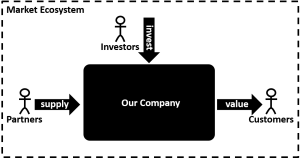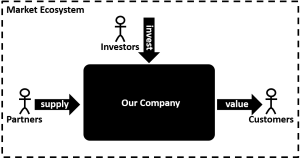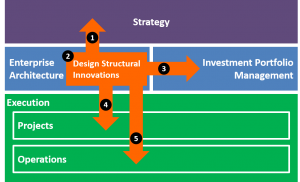
Enterprise architecture, on its own delivers no value. As illustrated in my blog on outside-in architecture, the final goal of enterprise architecture is to design structures that create business value.
Therefore enterprise architects operate on the link between strategy and execution, connecting the investment chain with the operational value chain. To be able to improve the structure of enterprises, enterprise architects have to collaborate with business executives, investment portfolio managers, project teams and operational people as illustrated in the following picture:
In this blog I want to share my insights on how I see these collaborations happening in practice. Be aware that I will explain the collaborations top down, which in practice will often not be the case. In my experience, I mostly jump in at the project level to create early value and continue my journey from there on.
1. Analyze strategy (scenarios) for structural impact
To understand where to play as an enterprise architect, it is important to understand where the organization wants to go. Even if the organization does not have an explicit strategy, at least you can connect with people leading the organization to find out about their goals, directions and constraints. In most of the enterprises I worked for, I could find elements such as strategy documents, roadmaps, balanced scorecards or business plans that provided me a lot of input.
From my experience, the best way to understand what really matters is to talk to people. It gives you a good indication of the company culture which is maybe even more important than the formal strategy.
The role of the enterprise architect is to understand what the impact of the strategy is on the shape and structure of the enterprise.
I found it also very valuable to explore strategy scenarios. Since companies are operating in rapidly changing environments, it is my experience that discussing about long term roadmaps is not a very agile approach on strategy planning. It is better to explore different strategy scenarios and analyze their impact so at least you are prepared to act faster when external factors change.
2. Design structural innovations
The main activity of enterprise architects is to design structural innovations that enable the implementation of the strategy of the company.
I’ll take the example of an enterprise in a B2C context who wants to change from a company centric inside-out strategy to a consumer centric outside-in strategy. Something which I see happening today in a lot of companies.
The role of the enterprise architect is to design structural innovations that enable sustainable execution of the strategy.
If your company strategy is about consumer centricity, you might consider the following structural innovations:
- Start every interaction from the real needs of the consumer (instead of from what you think the consumer needs)
- Build consumer relationships in all your contacts, across channels, in every touchpoint (instead of separating processes for sales, service delivery, support and administration and confusing the consumer in how you appear in his experience)
- Manage consumer information as a core business asset (next to other more ‘inside’ oriented information assets such as contracts, products, payments, orders, …)
- Combine consumer information with products to personalize services (instead of pushing a complex and difficult to understand product portfolio to the consumer)
3. Realize structural innovation through investments in change
To realize structural innovations, enterprises need to invest in changes to make them happen. Therefore enterprise architects need to collaborate with the investment portfolio managers who decide upon the investment strategy of the company.
The structural innovations can be integrated in the project portfolio of the company by inserting specific projects in the portfolio or by integrating structural innovations in already existing projects and operations.
If we take the example from above (starting from a consumer centric strategy), we could define a specific project to adapt the organization model from a functional silo organization (with separate commercial and operational departments) to a consumer oriented model with a specific organization structure to build consumer relationships in all touchpoints. And invest in a specific project to make this change happen.
The role of the enterprise architect is to integrate structural innovations in the investment portfolio of the company.
Other structural innovations such as ‘start from real consumer needs’, can be integrated as an architectural principle in all projects and operational processes that touch the consumer.
As an enterprise architect, it is important to understand how the investment portfolio is composed. What changes are we investing in? How can we integrate our structural innovations in the investment portfolio of the enterprise?
4. Implement structural innovations through execution of projects
Once the investments are decided, the actual changes will have to be implemented inside projects. To make sure that the changes are being realized in a structural way, enterprise architects have to collaborate with project teams. Explaining why the structures are needed, referring to the strategic objectives of the company.
The role of enterprise architects is to guide projects in implementing structural innovations that implement your strategy.
This is where you have the typical conflict of interest between architects and project managers, balancing structural objectives and delivery objectives. A discussion which you can only argument as an architect, if you can link your structural innovations to the strategy of the company.
5. Exploit structural innovations for value creation
Of course the final goal is to create value with structural innovations. The job is only finished when the investments can be exploited to create real value. For enterprise architects this consideration can mean several things:
- If you see that an investment is not going to deliver its promised value, you have to be courageous!
- When you design structures, you have to imagine from the beginning how the structure will be exploited. Put yourself in the shoes of the customer and the operational people!
- And of course, once the investment has been made. Exploit it as much as you can. Maybe even for purposes that were not originally foreseen.
- Which brings us back to the investment portfolio. Because as an enterprise architect, we typically have very good knowledge of the existing assets of the company, we can also think about how to exploit what we already have in better ways. So we don’t need to invest every time in new things and can avoid ‘needless’ investments.
The role of enterprise architects is to optimize return of investments by maximizing exploitation of enterprise structures for value creation.
What a difference we can make, if we can connect strategy to operations. By integrating EA with strategy, investment management, program and project management and operations.




